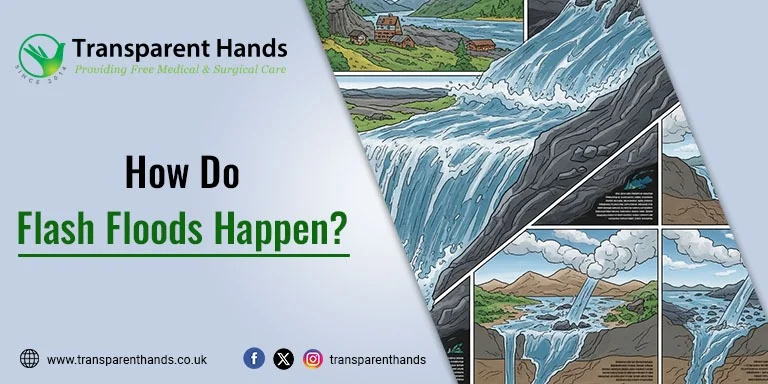How Do Flash Floods Happen?

Floods have been creating headlines lately, especially in Pakistan, where they have caused mass-scale destruction. According to the latest stats, 5.8 million people in Pakistan are affected by floods.
While the phenomenon isn’t new, many of us are not aware of the causes of flash floods. In this article, we will discuss why flash floods occur and why they are so devastating. We will also address one of the most frequently asked questions in recent weeks: how do flash floods happen?
What are Flash Floods?
Flash floods can occur anywhere and happen very quickly. According to NASA, flash floods occur within six hours of heavy rainfall, providing barely any time for evacuation. However, they can happen much quicker and can catch anyone off guard within a few minutes.
The most frequently quoted reason for the occurrence of flash floods is excessive rainfall in a brief time span. However, it may also happen in the wake of a levee or a dam failure. In fact, any incident that results in a sudden and massive release of water can unleash a flash flood. The reason behind flash floods isn’t simply the intensity of water. The real damage is incurred when the ground is unable to absorb or drain water. A flash flood can quickly erode infrastructure, carry forward debris, and destroy anything that comes its way.
Flash floods typically occur in areas where rivers are narrow but steep. Urban areas built near rivers may increase the danger of flash floods. The reason is that hard surfaces such as concrete and roads don’t absorb water into the ground. These systems can only process a certain degree of water. Once the drainage systems get overwhelmed, flash flooding can occur.
Damage Caused by Floods in Pakistan:
In 2022, Pakistan experienced arguably the most destructive floods in its recent history. Almost one-third of the country was submerged in water. According to the World Bank, Pakistan incurred a loss of at least US$30 billion during that period.
This year, Pakistan is going through a similar predicament. Till now, the floods have affected more than 4.2 million Pakistanis, displacing over 2.4 million people.
A total of 928 people are reported dead, while 1,051 people are injured. Over 4400 villages in Punjab have been affected alone. Floods have also caused substantial losses to infrastructure. Over 671 km of roads have been damaged, while more than 8,182 houses have been either destroyed or partially damaged.
How Do Flash Floods Happen?
Climate change is the major driving factor behind frequent floods in Pakistan. According to the UNDP, Pakistan is the 8th most vulnerable country in the world to the impact of climate change. The following are some of the factors that impact Pakistan:
Melting Glaciers: Climate change has raised Earth’s average temperature, melting Pakistani glaciers at a quicker rate. The result is a surplus of water that plays a major role in triggering floods.
Cloudbursts: Due to the increase in temperature, cloudbursts have become more frequent in Pakistan. Cloudbursts can generate an enormous amount of rain within a short period of time, leading to flash floods.
Infrastructure and Proximity to Rivers: As discussed earlier, urban infrastructure built close to rivers can be hazardous, making these communities more vulnerable. Additionally, it doesn’t allow for the absorption of water into the ground. To accommodate the needs of a growing population, urban infrastructure projects are often constructed near rivers and streams. That is why flash floods have been causing significantly more damage.
Pakistan needs international support to deal with environmental issues. According to the UN, Pakistan only contributes 0.93% to the global GHG emissions. However, it ranks 150 in the climate vulnerability index. Simply put, Pakistan has very low carbon emissions, but it is one of the most vulnerable countries when it comes to climate change. What makes the situation even worse is that Pakistan ranks 161 on the Human Development Index.
With this alarming situation, we must go the extra mile to assist the flood victims who have lost their homes, belongings, and loved ones. They are now facing a growing crisis which includes hunger and outbreaks of disease.
How to Help Flood Victims in Pakistan?
The most immediate challenge is to keep the flood survivors well-fed, provide first aid for the injured, and prevent the outbreak of diseases. Besides shelters, the flood victims require tents, clothes, food, mosquito nets, medical checkups, diagnostics, and medicines.
How is Transparent Hands Helping Flood Victims?
Transparent Hands was one of the first charitable organizations to provide relief to the flood survivors. We launched our flood relief operations and sent our medical teams to the most-affected areas.
Till now, we have helped over 5,700 flood victims in Buner, Mingora, Dera Ghazi Khan, Babu Sabu, Sahiwal, Shangla, and Karyal.
This year, we aim to organize more than 200 free flood relief camps, providing food packages, medical check-ups, first aid, diagnostics, medicines, tents, clothing, and mosquito nets to over 100,000 flood survivors. With your compassionate help, we may be able to exceed that number.
Donate to Transparent Hands now to provide immediate assistance to the flood victims. We have been supporting deserving Pakistani patients since 2014.
Note that we are a Shariah-compliant organization. We have a dedicated Shariah consultant to ensure that our operations are aligned with the rulings of Shariah. You can donate your Sadaqah and other donations without any hesitation.
In this article, we discussed, “How do flash floods happen?” We urge you to spread awareness about long-term environmental issues and how people from around the world can help flood victims survive by supporting Transparent Hands’ flood relief camps.
Donate without delay!










Leave a Reply